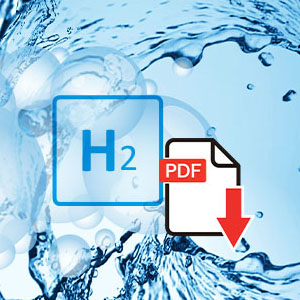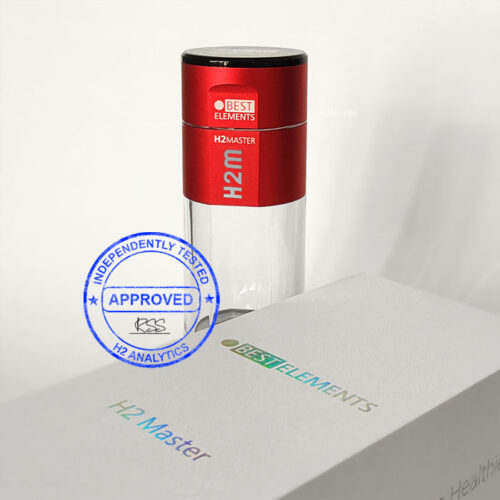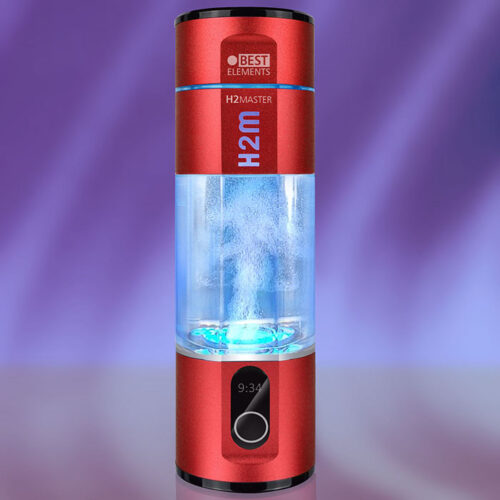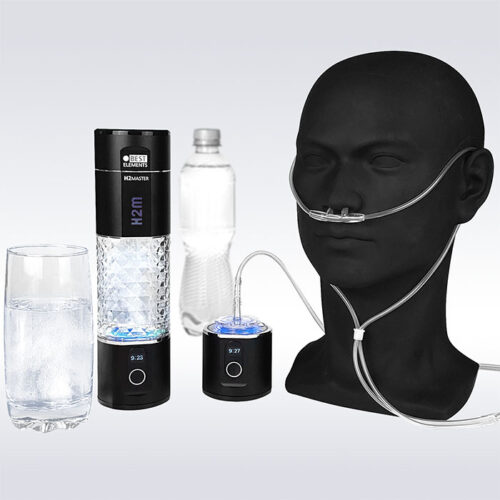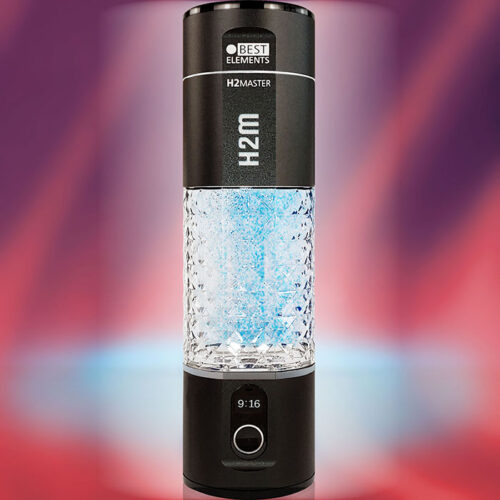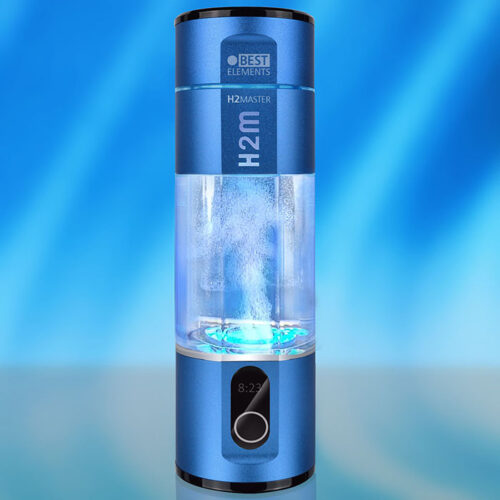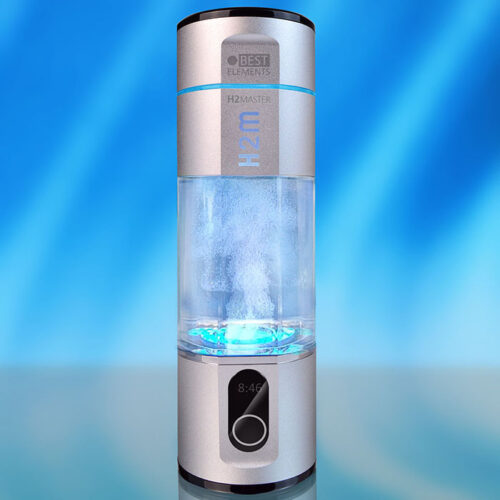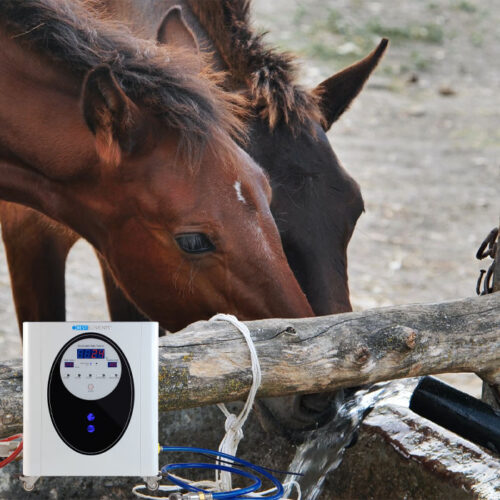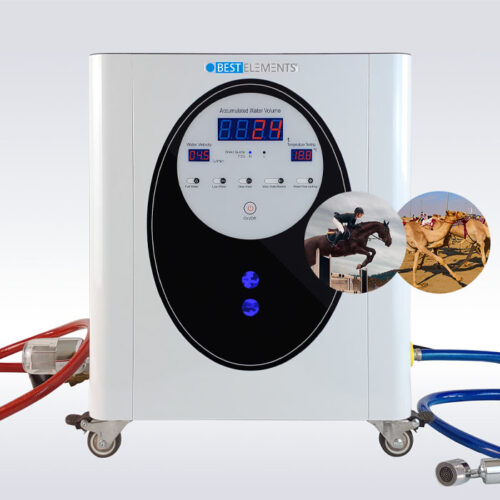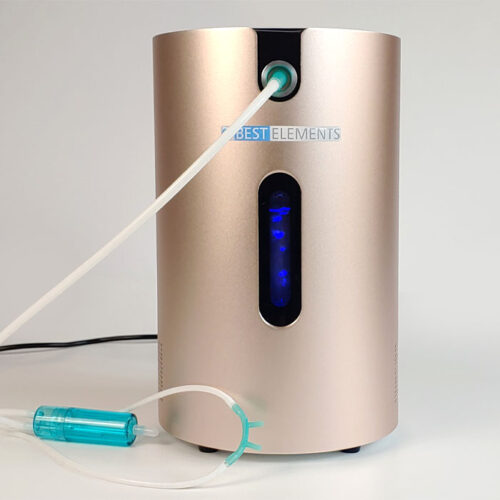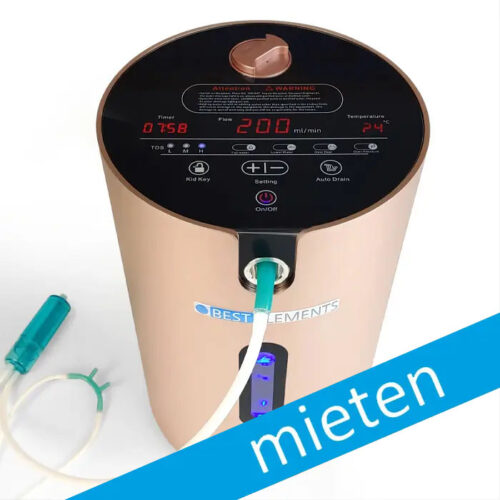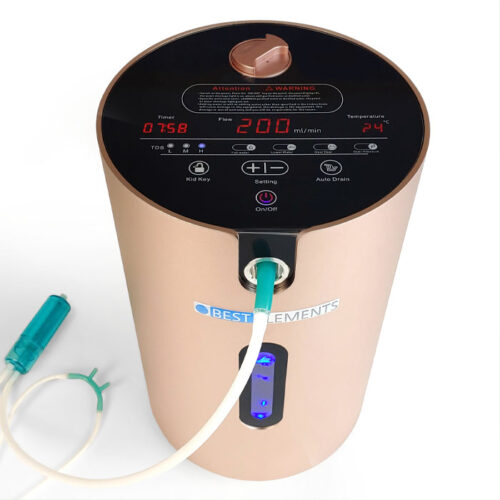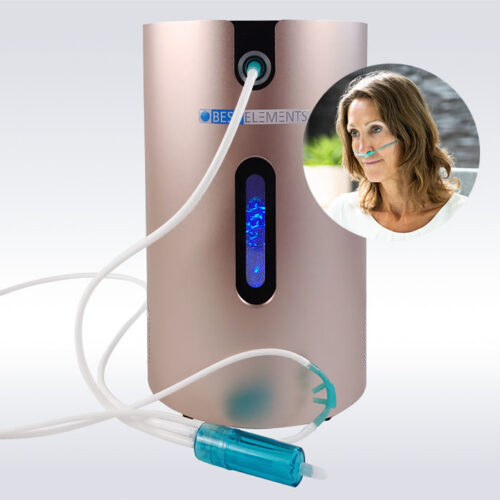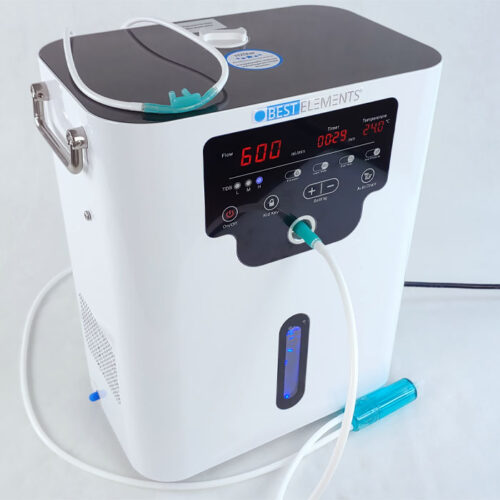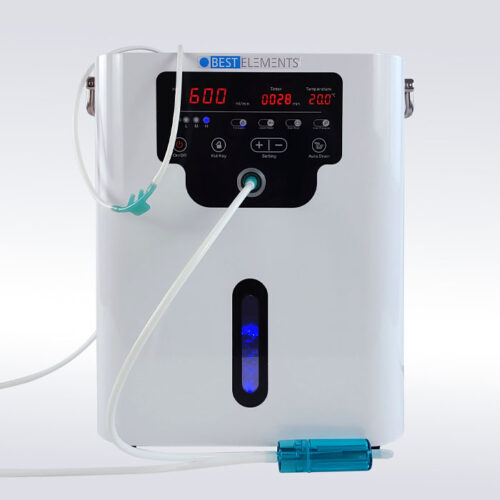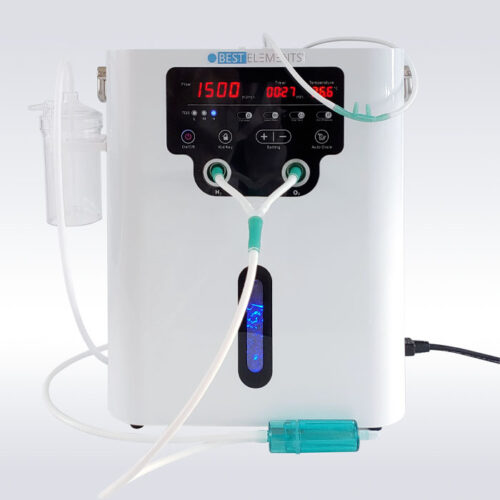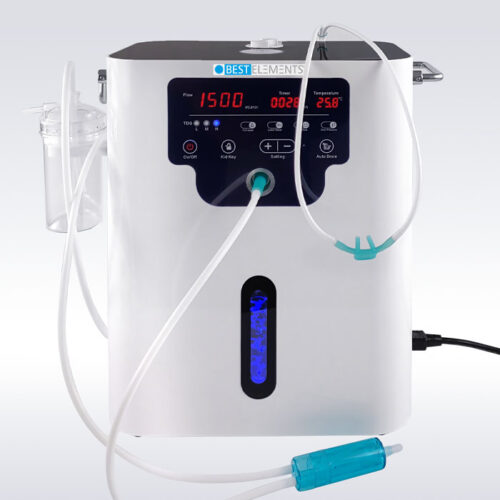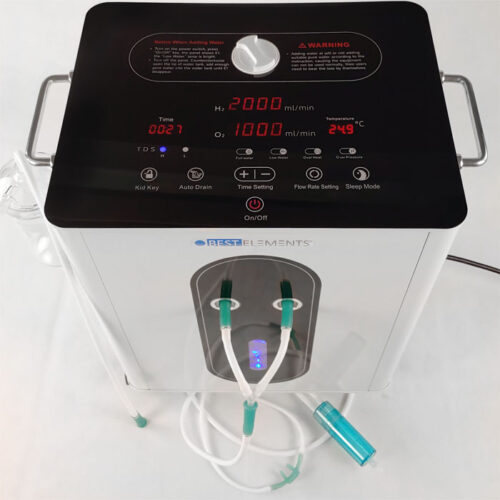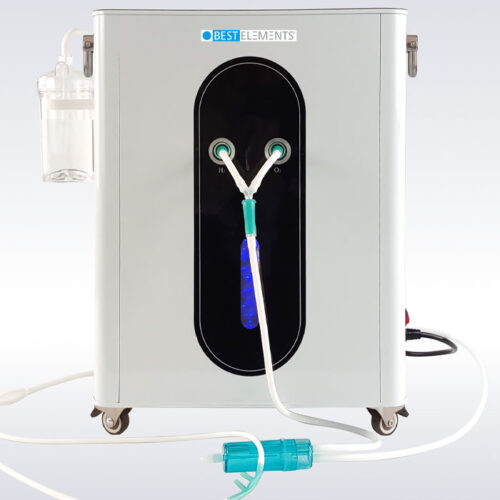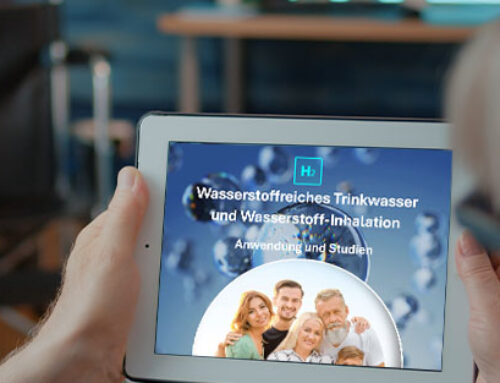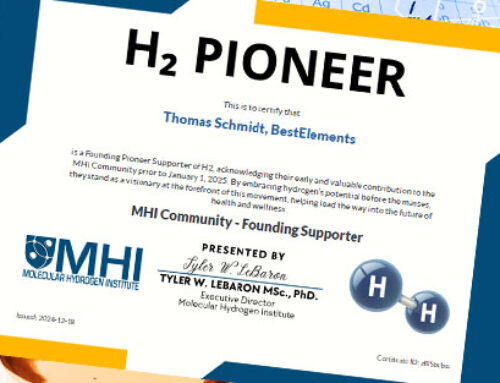Application of hydrogen-rich drinking water and hydrogen inhalation
Inhaling gaseous hydrogen or drinking hydrogen-enriched drinking water offers significant prophylactic and therapeutic benefits. Biomedical research shows that additional hydrogen has benefits in the body. On the one hand, oxidative stress and inflammation are reduced and taking it leads to a steady decline in joint diseases such as arthritis, which are based on oxidative stress and inflammation. Significant treatment successes have been achieved with hydrogen gas in Parkinson’s patients. Many other clinical pictures have been examined in studies and came to the same convincing conclusion.
Studies have even shown that hydrogen has a positive effect on losing weight by stimulating energy metabolism. An increase in growth hormone and therefore an increase in muscle tissue has been noted in athletes. Test subjects felt “energized” by being away. This enrichment is due to the effect of hydrogen on the mitochondria – the “energy power plants” in our cells.
Reduction equivalents to produce energy in the form of ATP are stimulated and other forms of energy become usable. Inflammation and oxidative stress are inhibited. After taking hydrogen you feel fresher, more alert and clearer in your head.
Where do the positive health benefits of hydrogen come from?
Many compounds of nutrients and vitamins consist of hydrogen compounds and bacteria also produce hydrogen in the human intestine. However, this is not sufficient for many processes in the body and it has been proven to be organically helpful to absorb additional hydrogen. Among other things, there are options for dissolving hydrogen in drinking water or inhaling it via an inhaler.
Even small additional amounts of molecular hydrogen have been proven to provide therapeutic benefits and bring health and performance-enhancing benefits.
When inhaled, the hydrogen goes directly through the lungs into the bloodstream. At Kyushu University in Japan, they found that drinking hydrogen water will cause an increase in the gastrointestinal hormone ghrelin in the stomach. Ghrelin is partly responsible for controlling feelings of hunger and satiety and is a very good neuroprotector and anti-inflammatory. The hormone FGF21 is secreted, which is responsible for metabolic disorders and subsequently increases DNA repair mechanisms.
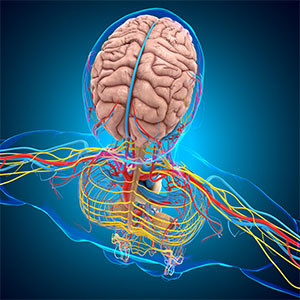
When and for how long does hydrogen work in the body?
The hydrogen works very quickly in the body. Due to the extremely small size of the hydrogen molecules, they can penetrate cell membranes and overcome barriers in the body. No other antioxidant can do this. Vitamins are fat-soluble, hydrophobic and usually remain in cell tissue. It has been found that excessive use of these antioxidants as supplements can lead to adverse health effects.
Hydrogen, on the other hand, has an effect in all areas of the body such as the blood, organs, muscles, bones and brain from around 5 to 10 minutes after ingestion. The molecules bind disruptive oxygen radicals in the cells, combine to form water and leave the body just as quickly, whether as excess hydrogen or bound as water with the oxygen radicals, which are transported out of the body in this way. After about 1 to 2 hours, the H2 saturation in the body is back to its original level and the organism is ready for a new application. Time intervals are helpful in administration. When inhaling Brown’s gas with 2/3 hydrogen and 1/3 oxygen, the time it stays in the body is longer.
How often can you drink hydrogen-rich drinking water or inhale hydrogen?
Hydrogen is quickly volatile and the saturation gases out quickly after preparation in open jars within 20-30 minutes to 2 hours. So you should drink the hydrogen-rich water immediately after preparing it. With the hydrogen booster, the amount in the H2Master of 200-300 ml practically corresponds to a drinking glass. This amount can be drunk several times a day.
H2 inhalation with BestElements inhalers can also be carried out several times a day from 30 minutes to several hours. The well-being during prophylaxis and performance improvement or the therapy goal decide this. There is no upper limit and no too much, neither in the prophylactic nor in the therapeutic area. What is not absorbed by the body is exhaled or escapes through the skin.
The inhalation can be carried out hourly in the therapy center or integrated into everyday life at home. You can inhale while working at your desk or comfortably in an armchair or on the couch.

Should you use tap water, mineral water or filtered water?
In general, the purer the water, the easier it is for our bodies. Water has a transport function that transports nutrients within our body and we generally obtain nutrients and minerals from a balanced and varied diet. You couldn’t cover your daily mineral needs with mineral water; the content in the water in the form of bound salts is often not sufficient, even just to support it (further information on this here).
Tap water has been proven to contain many substances that are not even tested in drinking water analysis. Even if the limit values of the approximately 50 tested substances are not exceeded, drug residues, phthalates, bisphenols, hormone-like substances, PFAS, drug residues and many other new compounds can be contained in the water that waterworks cannot easily remove (further information here) .
Filtered water – ideally through reverse osmosis – has proven to be very effective. Pure water without impurities is the best for the organism to maintain its full functioning. Filtered water also enables the full potential of hydrogen boosters. (more information about reverse osmosis here)
Good things remain, harmful things are removed
There are also oxygen radicals that are responsible and helpful for our body’s defenses. These have a lower binding force and are not combated by hydrogen. Only the highly aggressive, binding free radicals and reactive oxygen species (ROS), such as the toxic and cell-damaging hydroxyl radical (OH), which arise during energy metabolism in the cells and which the body cannot otherwise break down, combine with the hydrogen molecules. Such cell damage and reproductive errors lead to functional disorders and premature aging processes.
Hydrogen acts exactly at these points as a so-called selective antioxidant by only eliminating cell-damaging oxygen radicals and removing them from the body as a water compound. Useful free radicals, such as nitric oxide (NO), which are responsible for the expansion of blood vessels in our veins or which are needed by the immune system to combat microorganisms, viruses and toxins, are retained.
Fine dust increases oxidative stress in the lungs
Among other things, particulate matter, a particularly serious form of air pollution, damages our health by converting peroxides in the lungs into more reactive species such as hydroxyl radicals, as researched at the Max Planck Institute. It is therefore important to minimize fine dust as best as possible. This can be done at home and in offices with effective air purifiers.
How does hydrogen get into the water?
Water is generally able to absorb gaseous hydrogen, although hydrogen is only present in the atmosphere in the minimum per mille range. Hydrogen is technically produced through what is known as electrolysis, but this can be done using different technologies. During this process, water (H20) is separated into hydrogen and oxygen.
In this way, one liter of water can absorb 1.6 mg of hydrogen at normal pressure. This corresponds to 1.6 ppm (parts per million) or 1600 ppb (parts per trillion). Saturation can be increased by applying pressure in a container and good hydrogen boosters, such as the H2Master, achieve H2 saturations of 5140 ppb, which have been proven in the laboratory.
The hydrogen is dissolved in the water in invisible nanobubbles, visible bubbles rise during the process and many of them dissolve. The invisible nanobubbles created by the bubbling are crucial for the hydrogen content. Water temperatures of around 35°C have proven to be the optimal processing and drinking temperature to achieve the highest values. The water remains still water, the bubbles have no fizzy effect like carbonic acid. That’s not intentional either.
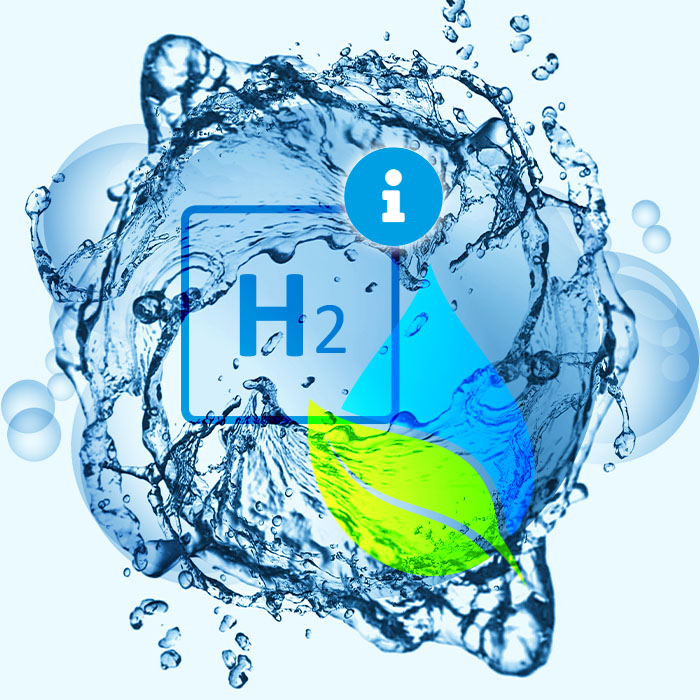
Which electrolysis technique is recommended?
Hydrogen is formed at the cathode during electrolysis. In order for the protons to move from the anode to the cathode, modern devices use a proton exchange membrane (PEM). This enables ion exchange best in the construction of a solid polymer electrolyte (SPE). The H2Master hydrogen boosters work with this technology. The maintenance effort is extremely low and is almost zero. Only lime deposits when using hard water need to be removed, similar to kitchen machines. This is not the case with filtered water.
Modern inhalers also use this technology and do not require media such as potassium hydroxide or sodium hydroxide (caustic soda) for electrolysis, which can cause skin irritation and serious eye damage/irritation and require increased maintenance. Hydrogen inhalers like these H2 inhalers from BestElements work with double-distilled water, which only needs to be refilled when necessary. There is no additional maintenance required, the functionality is safe and easy for users to use.
How can you measure hydrogen content?
The simplest and best method for detecting the amount of dissolved hydrogen in drinking water is to use special drops of a reagent solution that use methylene blue and a portion of platinum to cause a reaction with the hydrogen, which decolorizes the solution. One drop corresponds to 0.1 ppm. 10 drops therefore demonstrate a dissolved hydrogen content of 1 ppm = 1000 ppb in the water.
The measurement with a measuring device for the oxidation-reduction potential (ORP, redox), which measures the redox value and thus the oxidizing ability of the water, is inaccurate and not very meaningful. A value of -500 mV could correspond to a hydrogen content of 1000 ppm or even just 100 ppm, which would be significantly less therapeutically effective. Only a neutral or positive ORP value would prove the absence of dissolved hydrogen. The higher the value, the higher the oxidizing properties of the water. This value plays a role when disinfecting pools with chlorine.
Likewise, banging effects with a lighter under a jet of hydrogen water say nothing about H2 saturation – only that hydrogen is present in bubbles in the water jet, which can then quickly dissolve due to the movement of the water and do not end up in the water glass or in the body.
Gas-liquid chromatography is used in laboratories, which provides an exact value of the chemical composition.
Sources: National Institutes of Health, Nature Medicine Journal, Max Planck Institute, Naomi Kamimura, Kiyomi Nishimaki, MSc. PhD Tyler W. LeBaron, Molecular Hydrogen Institute, Ikuro Ohsawa, Shigeo Ohta
Further questions and answers
Around 1950, Bulgarian electrical engineer Ilia Valkov escaped to Australia, albeit indirectly. A US major, Yull Brown, helped him. Out of gratitude (or perhaps other reasons), Ilia took his name and studied electrical engineering in Sydney. He discovered that when the hydrogen and oxygen gases produced during electrolysis are burned exclusively together, an exceptionally hot flame can be created, the temperature of which depends on the material it encounters. This can reach temperatures of around 6000°C, resulting in ionization, a so-called plasma. Without fuel, it is a so-called cold flame of approximately 100°C.
Independent of welding technology, developers in the USA continued to investigate the inhalation of both gases in the 1980s, and research teams, initially led by Japanese Professor Shigeo Ohta, among others, continued to research hydrogen inhalation, or rather the inhalation of hydrogen and oxygen, starting in the mid-2000s, and have documented this in over 1,000 studies with numerous scientists.
The term “Brown’s Gas” was adopted. Research on this topic continues. The team at BestElements Germany has been providing such inhalation devices with further developed models worldwide for several years, researching and documenting user experiences.
Hydrogen can modulate the activity of microbial communities, promoting a balanced microbiome. Dysbiosis, which disrupts H₂ metabolism, has also been linked to inflammatory bowel diseases such as colitis, where alterations in hydrogenase enzyme activity impair microbial composition and gut health. Beyond this, H₂ also increases the production of short-chain fatty acids, the primary energy source for colonocytes. This has been shown to protect the intestinal wall and reduce the occurrence of “leaky gut” (gaps in the intestinal lining through which bacteria can escape and inflammatory cells can enter). Gastro-supportive effects impact the gut microbiome, promoting gut health and minimizing or correcting dysbiosis—regardless of how the hydrogen is ingested.
We can drink hydrogen water, inhale hydrogen, let hydrogen flow over the skin, and take hydrogen baths. However, it is impossible to say which method is best. Hydrogen acts generally and holistically in the body, and the different variants can be used in parallel for maximum effectiveness. In cases of dysfunction or illness, absorption is best achieved through the affected areas. Drinking hydrogen water is therefore convenient and universally applicable, as well as for high blood lipids (cholesterol levels), high uric acid levels, ulcerative colitis, intestinal diseases, and other metabolic problems, as well as inflammation of the digestive tract. It can regulate the intestinal flora and prevent many intestinal diseases.
When inhaling hydrogen, the concentration is higher than when drinking hydrogen water; when drinking it, one is limited by the maximum daily fluid intake. Hydrogen inhalation is also particularly effective for respiratory tract dysfunctions such as lung, ENT, respiratory, and tracheal problems (asthma, emphysema, smog-induced lung damage), as well as for brain and nerve problems (stroke, Alzheimer’s disease).
Hydrogen application through the skin is particularly suitable for skin diseases, eczema, and anti-wrinkle care. But as mentioned above: hydrogen has a holistic effect on the body.
Current research confirms the anti-inflammatory, antioxidant, and anti-apoptotic (anti-cell death) effects of hydrogen. Inflammation, oxidative damage, and apoptosis are common cellular pathological lesions in the development and progression of most diseases. Therefore, it is not surprising that hydrogen intake is becoming increasingly popular.
Hydrogen is a very flexible gas with small molecules. It can reach all parts of the body unhindered. Many clinically used medications are blocked by the blood-brain barrier in the brain and cannot reach brain cells. Hydrogen, on the other hand, can easily reach the brain and exert positive effects there. Because hydrogen is highly soluble in adipose tissue and the fat content in the brain is high, the hydrogen concentration in the brain is relatively high. This could be an important reason for the relief of stroke, Parkinson’s disease, and Alzheimer’s disease.
BestElements’ hydrogen boosters and hydrogen inhalers are suitable for all age groups. There are no restrictions regarding age or physical condition. Hydrogen enriches the body’s cells and the human energy balance. Here you will find comprehensive answers to questions about the use of hydrogen-rich drinking water and hydrogen inhalation.
This hydrogen booster, BE H2, is not an ionizer for producing alkaline water. We do not have any conclusive studies confirming its improved effectiveness. Many studies have been conducted on hydrogen-enriched water. Our body needs water with a healthy pH. Even acidic foods like apples or lemons are ultimately metabolized by the body in an alkaline way – without the addition of alkaline water. Water can be made alkaline with additives such as baking soda.
No, still water remains still water. The added hydrogen gas is not perceptible like carbonic acid.
Hydrogen-enriched products can be consumed for an unlimited period of time. This limited consumption applies to medicinal waters, for example.
Ja, unsere Geräte arbeiten mit SPE/PEM Ionenmembranen höchster Qualität und mit Sicherheitskomponenten. Die Technik zur Trennung von Wasserstoff und Sauerstoff gewährleistet eine hohe Trinkwassersicherheit. Über die Entlüftungsfunktion der Membran werden Chlor und entstehendes Ozon entfernt. Auch Schwermetalle und weitere Stoffe werden beim Trennungsvorgang entfernt. Die platinbeschichtete Elektrodenplatte verfügt über vielporige Öffnungen, durch die ein hoher Wassertoffgehalt mit langer Verweilzeit erreicht wird.
Hydrogen is energy for our bodies: Molecular hydrogen (H2) is the smallest element and is gaseous at room temperature and normal pressure. It enters our cells when absorbed and is required as an energy source for our body’s energy metabolism. This metabolism takes place in the mitochondria within our cells, primarily in cells with high energy consumption such as muscle cells, nerve cells, sensory cells, and egg cells. Due to its high binding capacity, it binds to unwanted free radicals and transports them out of the organism. This makes energy metabolism more efficient, and self-healing powers are reactivated. Here, we discuss how it works in detail.
Powerful hydrogen generators for everyday use overview
Mobile hydrogen boosters with high performance values for better personal performance
The following powerful hydrogen boosters, hydrogen filters for hydrogen-rich drinking water and hydrogen inhalers for inhaling hydrogen are very suitable for everyday use, they are certified and reliably supply our body cells with this valuable elixir of life.

